Wolfram Function Repository
Instant-use add-on functions for the Wolfram Language
Function Repository Resource:
Plot the positions of solar system objects in 3D
ResourceFunction["SolarSystemPlot3D"][primitives] represents a three-dimensional graphical image for the current date that works with solar system entities as well as standard 3D graphics primitives and directives. | |
ResourceFunction["SolarSystemPlot3D"][primitives,date] represents a three-dimensional graphical image for the specified date that works with solar system entities as well as standard 3D graphics primitives and directives. | |
ResourceFunction["SolarSystemPlot3D"][primitives,{date1,date2}] represents a three-dimensional graphical image for the specified range of dates that works with solar system entities as well as standard 3D graphics primitives and directives. |
| "EclipticPlaneStyle" | Directive[GrayLevel[1],Opacity[0.2]] | style to use for drawing the ecliptic plane |
| "IncludeEclipticPlane" | True | whether to draw the ecliptic plane |
| "IncludeReferenceObjects" | False | whether to include important background reference objects |
| "IncludeSun" | True | whether to include the Sun |
| LabelingFunction | Automatic | how to label points |
| LabelingSize | Automatic | size to use for callout and label |
| "OrbitsToInclude" | Automatic | list of entities whose orbits to include |
| "OrbitStyle" | Automatic | style to use for drawing orbits |
| "SunStyle" | Automatic | style directives to use for rendering the Sun |
Plot the position of a planet:
| In[1]:= |
| Out[1]= | 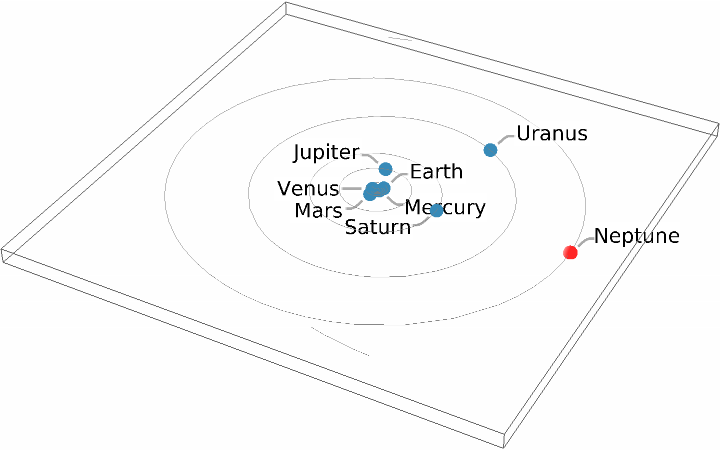 |
Plot the position of a minor planet:
| In[2]:= |
| Out[2]= | 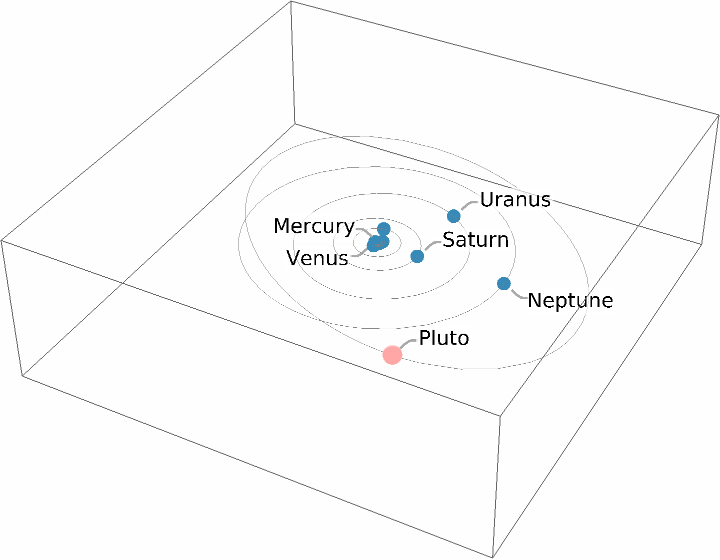 |
Plot the position of a comet:
| In[3]:= |
| Out[3]= | 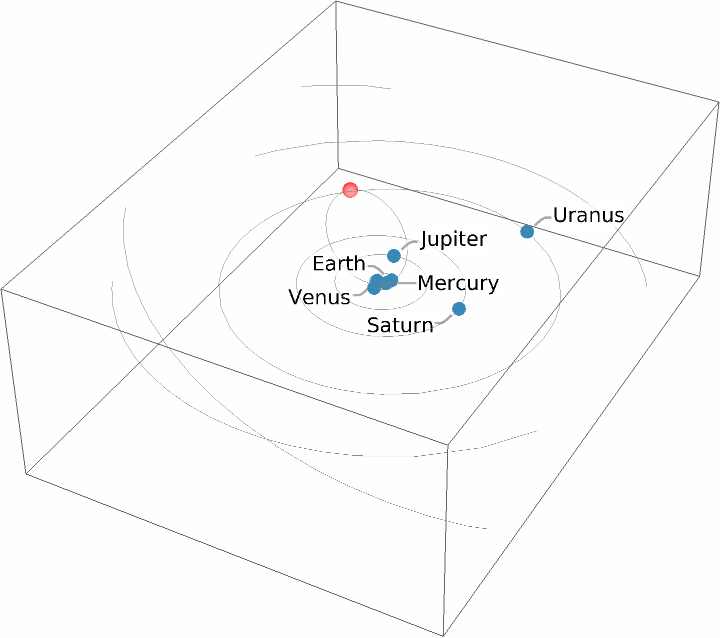 |
Plot the position of a deep space probe:
| In[4]:= | ![ResourceFunction[
"SolarSystemPlot3D", ResourceSystemBase -> "https://www.wolframcloud.com/obj/resourcesystem/api/1.0"][{Glow[Green], Sphere[Entity["DeepSpaceProbe", "NEWHorizons"], 2]}, PlotRangePadding -> 1]](https://www.wolframcloud.com/obj/resourcesystem/images/ae1/ae1361de-8cda-4b0f-a67e-0ca9d214f7d6/7f126ea4971ec1ba.png) |
| Out[4]= | 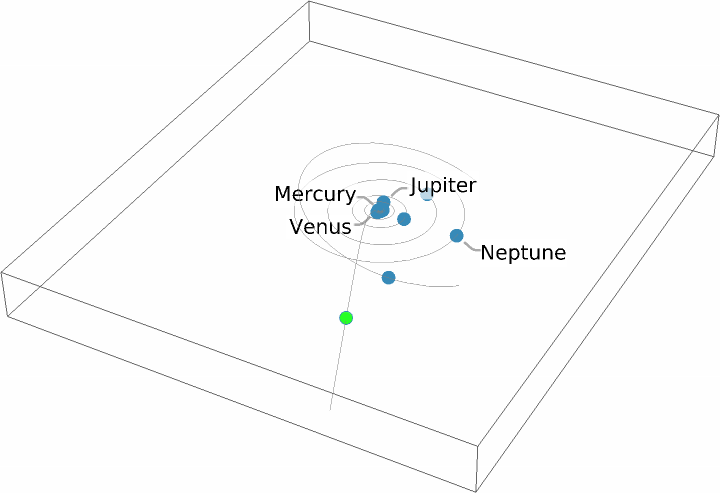 |
Plot the position of a planet on a specific date:
| In[5]:= | ![ResourceFunction[
"SolarSystemPlot3D", ResourceSystemBase -> "https://www.wolframcloud.com/obj/resourcesystem/api/1.0"][{Glow[Blue], Sphere[Entity["Planet", "Neptune"], 2]}, DateObject[{1986, 1, 3}, "Day", "Gregorian", -6.`], PlotRangePadding -> 2]](https://www.wolframcloud.com/obj/resourcesystem/images/ae1/ae1361de-8cda-4b0f-a67e-0ca9d214f7d6/312c7459bed5bc1a.png) |
| Out[5]= | 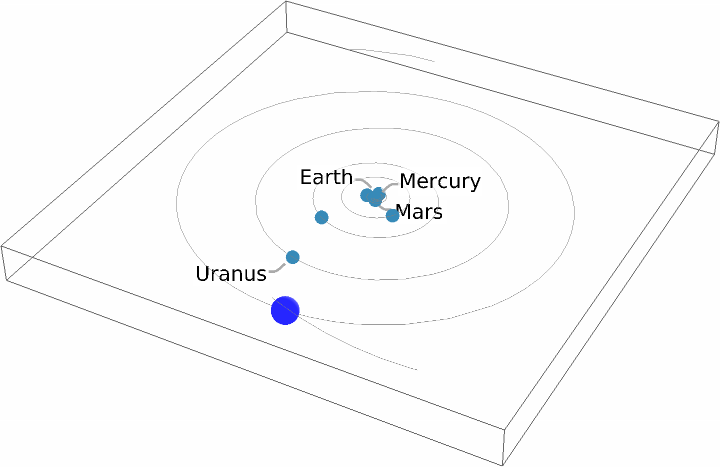 |
Plot the positions of multiple solar system objects:
| In[6]:= | ![ResourceFunction[
"SolarSystemPlot3D", ResourceSystemBase -> "https://www.wolframcloud.com/obj/resourcesystem/api/1.0"][{Glow[Blue], Sphere[Entity["Planet", "Neptune"], 2], Glow[Pink], Sphere[Entity["MinorPlanet", "Pluto"], 2], Glow[Green], Sphere[Entity["DeepSpaceProbe", "NEWHorizons"], 2], Glow[Red], Sphere[Entity["Comet", "Comet1PHalley"], 2]}]](https://www.wolframcloud.com/obj/resourcesystem/images/ae1/ae1361de-8cda-4b0f-a67e-0ca9d214f7d6/35ce7a986759e956.png) |
| Out[6]= | 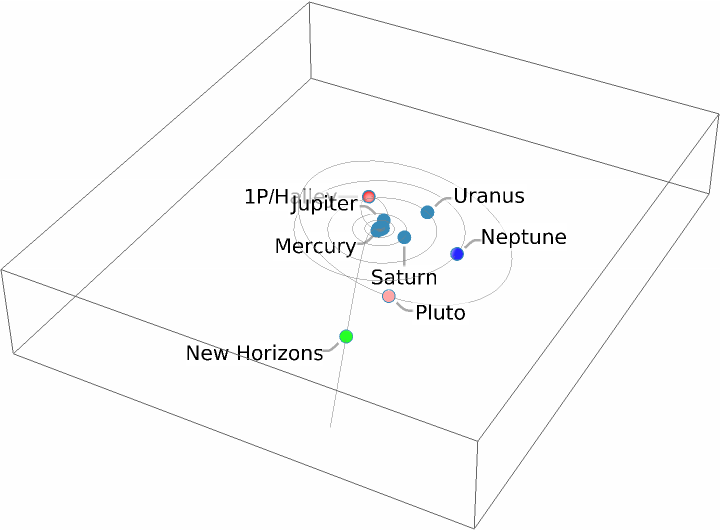 |
Plot the positions of multiple solar system objects on a specified date:
| In[7]:= | ![ResourceFunction[
"SolarSystemPlot3D", ResourceSystemBase -> "https://www.wolframcloud.com/obj/resourcesystem/api/1.0"][{Glow[Blue], Sphere[Entity["Planet", "Neptune"], 2], Glow[Pink], Sphere[Entity["MinorPlanet", "Pluto"], 2], Glow[Red], Sphere[Entity["Comet", "Comet1PHalley"], 2]}, DateObject[{1986, 1, 3}, "Day", "Gregorian", -6.`]]](https://www.wolframcloud.com/obj/resourcesystem/images/ae1/ae1361de-8cda-4b0f-a67e-0ca9d214f7d6/026ca455fdf089d2.png) |
| Out[7]= | 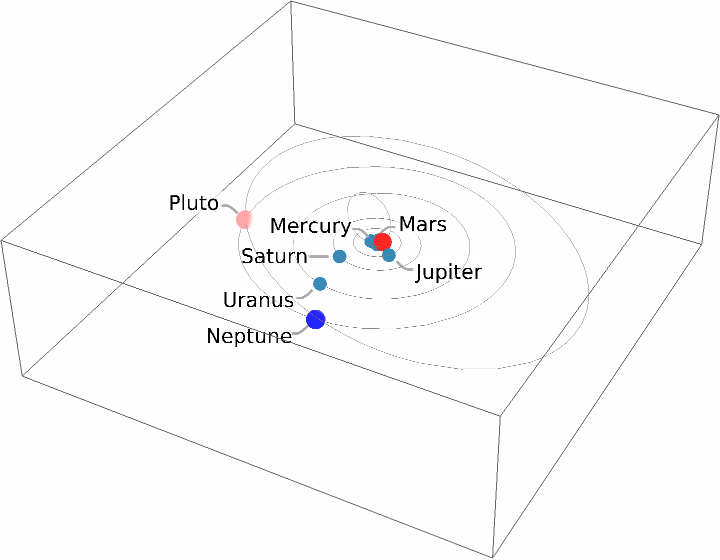 |
"OrbitsToInclude" can be used to specify which orbits should be included in the scene:
| In[9]:= | ![ResourceFunction[
"SolarSystemPlot3D", ResourceSystemBase -> "https://www.wolframcloud.com/obj/resourcesystem/api/1.0"][{Blue, Sphere[Entity["Planet", "Neptune"], 2]},
"OrbitsToInclude" -> {Entity["Planet", "Neptune"], Entity["MinorPlanet", "Pluto"]}]](https://www.wolframcloud.com/obj/resourcesystem/images/ae1/ae1361de-8cda-4b0f-a67e-0ca9d214f7d6/2fa4ec3380974a00.png) |
| Out[9]= | 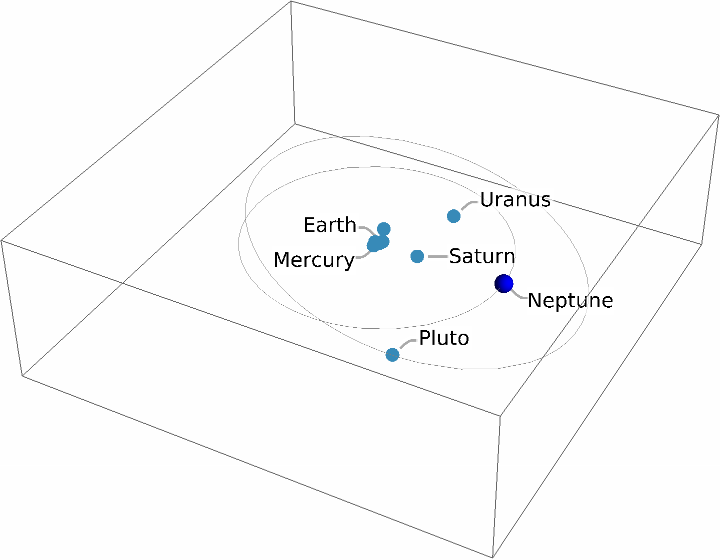 |
"OrbitStyle" can be used to style the orbits according to arbitrary styles and directives:
| In[10]:= |
| Out[10]= | 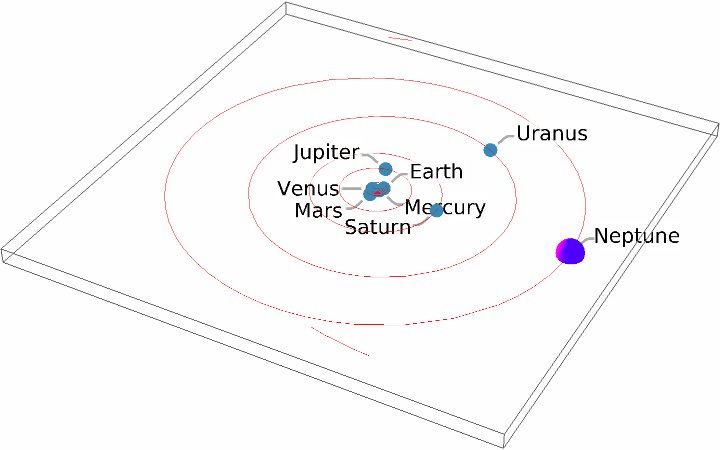 |
"IncludeSun" can be used to remove the Sun from the scene:
| In[11]:= | ![ResourceFunction[
"SolarSystemPlot3D", ResourceSystemBase -> "https://www.wolframcloud.com/obj/resourcesystem/api/1.0"][{Glow[Blue], Sphere[Entity["Planet", "Earth"], .1], Glow[Green], Sphere[Entity["Planet", "Venus"], .1], Glow[Gray], Sphere[Entity["Planet", "Mercury"], .1]}, "IncludeSun" -> False, PlotRange -> 1.7]](https://www.wolframcloud.com/obj/resourcesystem/images/ae1/ae1361de-8cda-4b0f-a67e-0ca9d214f7d6/442370b769f72f19.png) |
| Out[11]= | 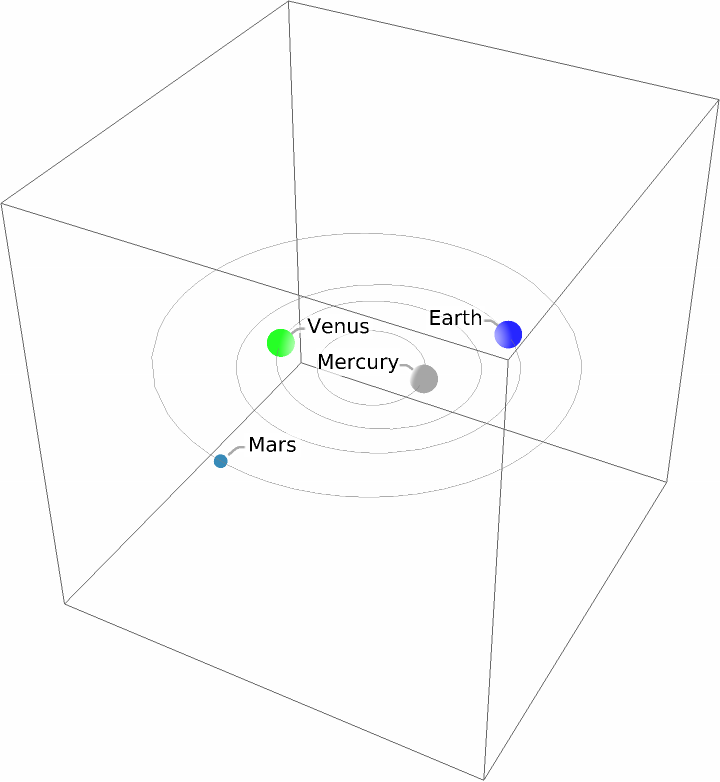 |
"SunStyle" can be used to change the directives and primitives used to create the Sun. By default, the Sun is drawn to scale as a yellow sphere:
| In[12]:= | ![ResourceFunction[
"SolarSystemPlot3D", ResourceSystemBase -> "https://www.wolframcloud.com/obj/resourcesystem/api/1.0"][{Blue, Sphere[Entity["Planet", "Earth"], .01],
White, Sphere[Entity["Planet", "Venus"], .01], Gray, Sphere[Entity["Planet", "Mercury"], .01]}, "SunStyle" -> {Red, Lighting -> {AmbientLight[GrayLevel[.3]], DirectionalLight[White, ImageScaled[{0, 0, 1}]]}, Sphere[{0, 0, 0}, .1]}, PlotRange -> 1.7]](https://www.wolframcloud.com/obj/resourcesystem/images/ae1/ae1361de-8cda-4b0f-a67e-0ca9d214f7d6/29898892de88b64c.png) |
| Out[12]= | 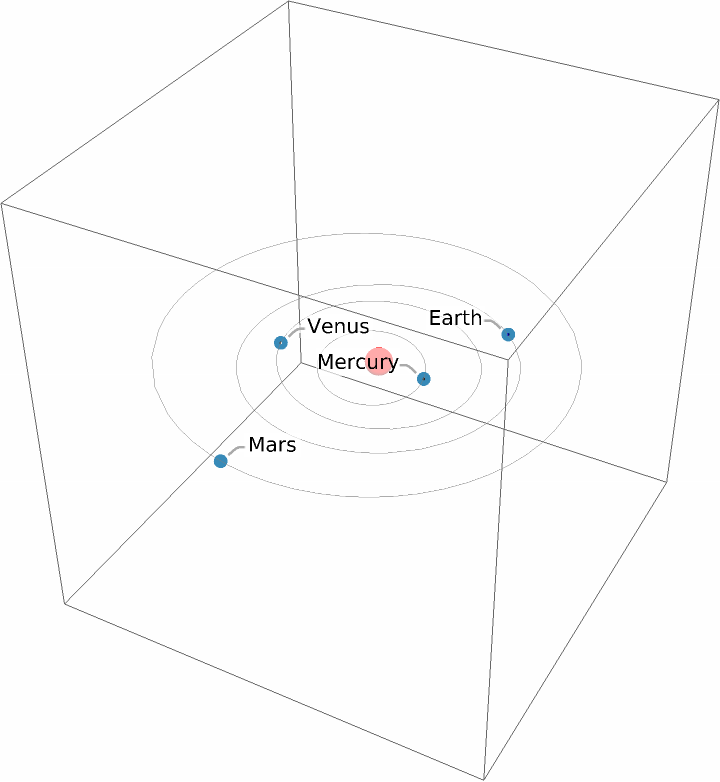 |
"IncludeEclipticPlane" is False by default, but can be set to True:
| In[13]:= | ![ResourceFunction[
"SolarSystemPlot3D", ResourceSystemBase -> "https://www.wolframcloud.com/obj/resourcesystem/api/1.0"][{Glow[Blue], Sphere[Entity["Planet", "Earth"], .1], Glow[White], Sphere[Entity["Planet", "Venus"], .1], Glow[Gray], Sphere[Entity["Planet", "Mercury"], .1]}, "IncludeEclipticPlane" -> True, PlotRange -> 1.7, "IncludeReferenceObjects" -> False]](https://www.wolframcloud.com/obj/resourcesystem/images/ae1/ae1361de-8cda-4b0f-a67e-0ca9d214f7d6/3caa8ffc1b5bbee7.png) |
| Out[13]= | 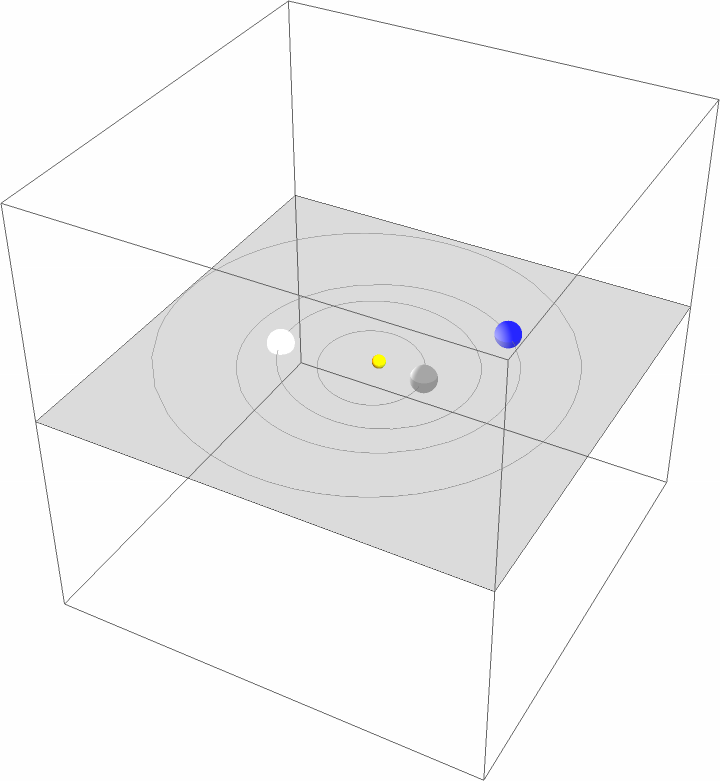 |
"EclipticPlaneStyle" can be used to specify the directives to use in styling the ecliptic plane:
| In[14]:= | ![ResourceFunction[
"SolarSystemPlot3D", ResourceSystemBase -> "https://www.wolframcloud.com/obj/resourcesystem/api/1.0"][{Glow[Blue], Sphere[Entity["Planet", "Earth"], .1], Glow[White], Sphere[Entity["Planet", "Venus"], .1], Glow[Gray], Sphere[Entity["Planet", "Mercury"], .1]}, "IncludeEclipticPlane" -> True, "EclipticPlaneStyle" -> Directive[Brown, Opacity[.6]], "IncludeReferenceObjects" -> False, "OrbitStyle" -> Cyan, PlotRange -> 1.7]](https://www.wolframcloud.com/obj/resourcesystem/images/ae1/ae1361de-8cda-4b0f-a67e-0ca9d214f7d6/57feaace59d978b5.png) |
| Out[14]= | 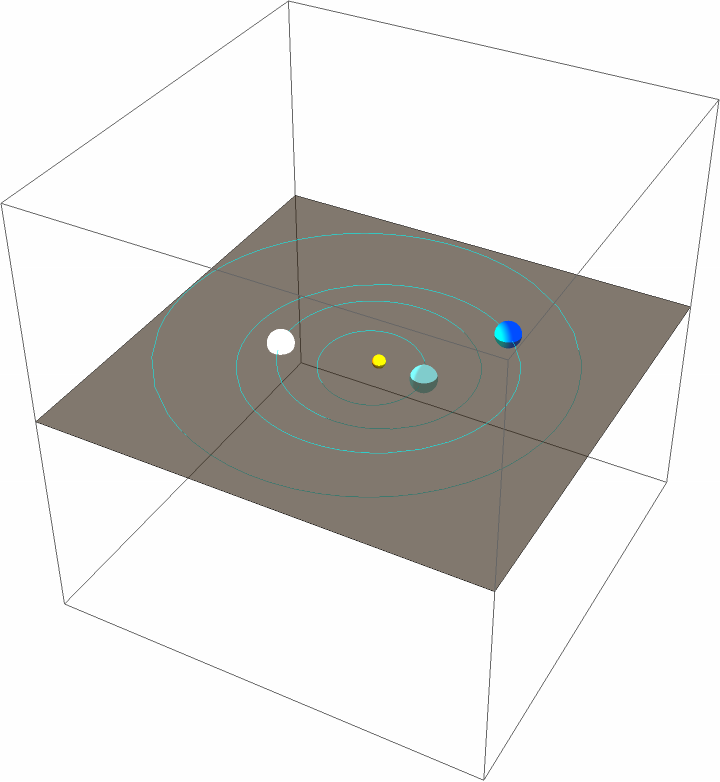 |
Force all callout labels to display:
| In[15]:= | ![ResourceFunction[
"SolarSystemPlot3D", ResourceSystemBase -> "https://www.wolframcloud.com/obj/resourcesystem/api/1.0"][{Glow[Cyan], Opacity[.2], EdgeForm[], Cone[{1.5 (Entity["Comet", "CometC2022E3ZTF"]), Entity["Comet", "CometC2022E3ZTF"]}, .05]}, DateObject[{2023, 1, 13}], ViewAngle -> Pi/200, LabelingFunction -> Callout]](https://www.wolframcloud.com/obj/resourcesystem/images/ae1/ae1361de-8cda-4b0f-a67e-0ca9d214f7d6/321c125263e1732b.png) |
| Out[15]= |  |
"IncludeReferenceObjects" can be set to False to avoid computing the positions of background reference objects:
| In[16]:= | ![ResourceFunction[
"SolarSystemPlot3D", ResourceSystemBase -> "https://www.wolframcloud.com/obj/resourcesystem/api/1.0"][{Glow[Orange], Sphere[Entity["Planet", "Jupiter"], .3]}, "IncludeReferenceObjects" -> False, PlotRangePadding -> .2]](https://www.wolframcloud.com/obj/resourcesystem/images/ae1/ae1361de-8cda-4b0f-a67e-0ca9d214f7d6/797c0952d1f69b85.png) |
| Out[16]= | 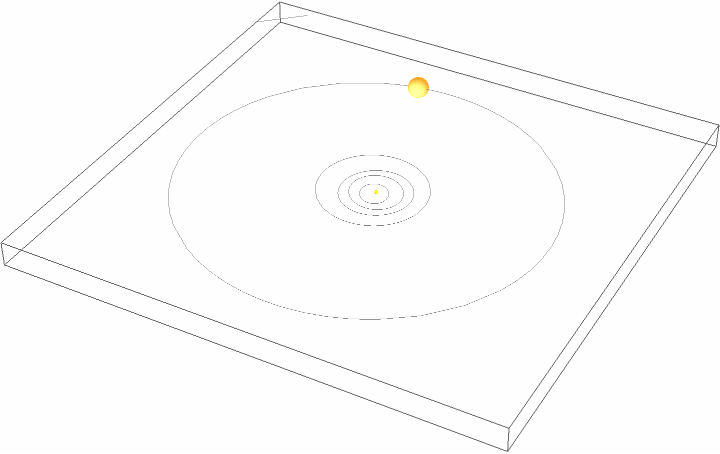 |
Visualize comet 46P/Wirtanen as it passes near the Earth:
| In[17]:= | ![With[{comet = Entity["Comet", "Comet46PWirtanen"]}, ResourceFunction[
"SolarSystemPlot3D", ResourceSystemBase -> "https://www.wolframcloud.com/obj/resourcesystem/api/1.0"][{LightBlue, Sphere[Entity["Planet", "Earth"], .02], Cyan, Sphere[comet, .01], EdgeForm[], Glow[Cyan], Opacity[.3], Cone[{1.1 comet, comet}, .02]},
DateObject[{2018, 12, 15}, "Day", "Gregorian", -6.`], Background -> Black, Boxed -> False, PlotRange -> 1.2, SphericalRegion -> True, ViewCenter -> {.6, .85, .5}, ViewAngle -> Pi/20, Lighting -> {PointLight[White, {0, 0, 0}]}, "IncludeReferenceObjects" -> False]]](https://www.wolframcloud.com/obj/resourcesystem/images/ae1/ae1361de-8cda-4b0f-a67e-0ca9d214f7d6/7592cff39d88f179.png) |
| Out[17]= | 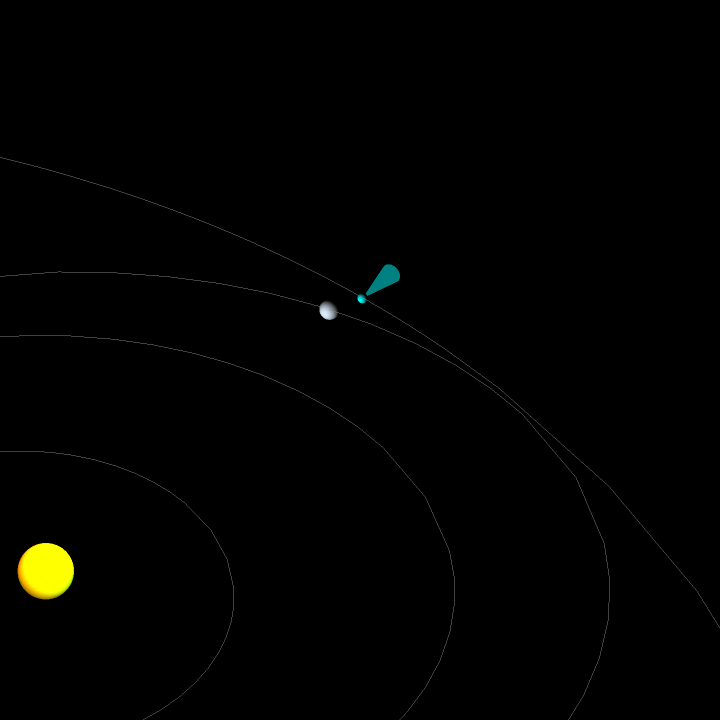 |
Track Elon Musk's Tesla in space:
| In[18]:= | ![With[{tesla = Entity["DeepSpaceProbe", "FalconHeavyDemonstrationMission"]},
ResourceFunction[
"SolarSystemPlot3D", ResourceSystemBase -> "https://www.wolframcloud.com/obj/resourcesystem/api/1.0"][{Glow[Red], Sphere[tesla, .05]}, DateObject[{2020, 9, 1}], PlotRange -> 2.1, ViewPoint -> Above, Boxed -> False, ViewAngle -> Pi/7]]](https://www.wolframcloud.com/obj/resourcesystem/images/ae1/ae1361de-8cda-4b0f-a67e-0ca9d214f7d6/76fbe7621b05eb48.png) |
| Out[18]= | 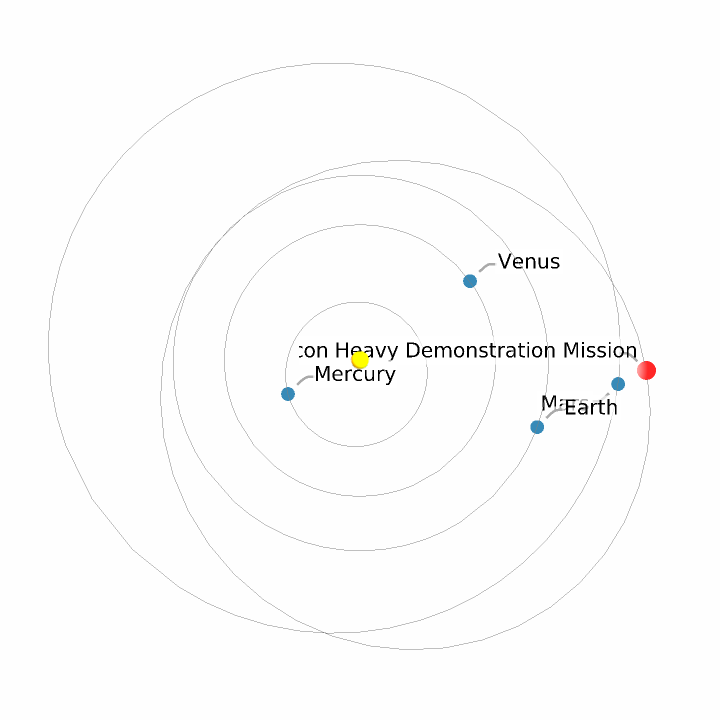 |
The coordinates of some objects may not be available or may have restrictions on which dates they are available, which can result in invalid coordinates for a 3D scene:
| In[19]:= |
| Out[19]= | 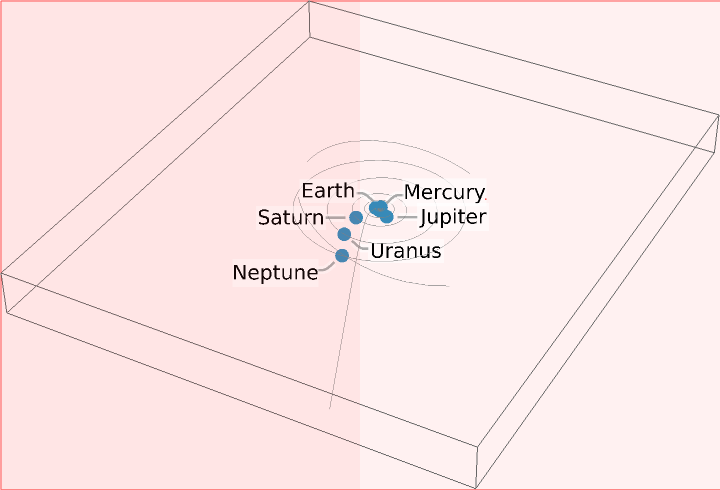 |
Simulate the inner planets being illuminated by the Sun:
| In[20]:= | ![ResourceFunction[
"SolarSystemPlot3D", ResourceSystemBase -> "https://www.wolframcloud.com/obj/resourcesystem/api/1.0"][{Green, Sphere[Entity["Planet", "Earth"], .1],
White, Sphere[Entity["Planet", "Venus"], .1], Gray, Sphere[Entity["Planet", "Mercury"], .1]}, PlotRange -> 1.7, ViewPoint -> Top, Boxed -> False, Background -> Black, "IncludeReferenceObjects" -> False]](https://www.wolframcloud.com/obj/resourcesystem/images/ae1/ae1361de-8cda-4b0f-a67e-0ca9d214f7d6/02649af4c9b9cea2.png) |
| Out[20]= | 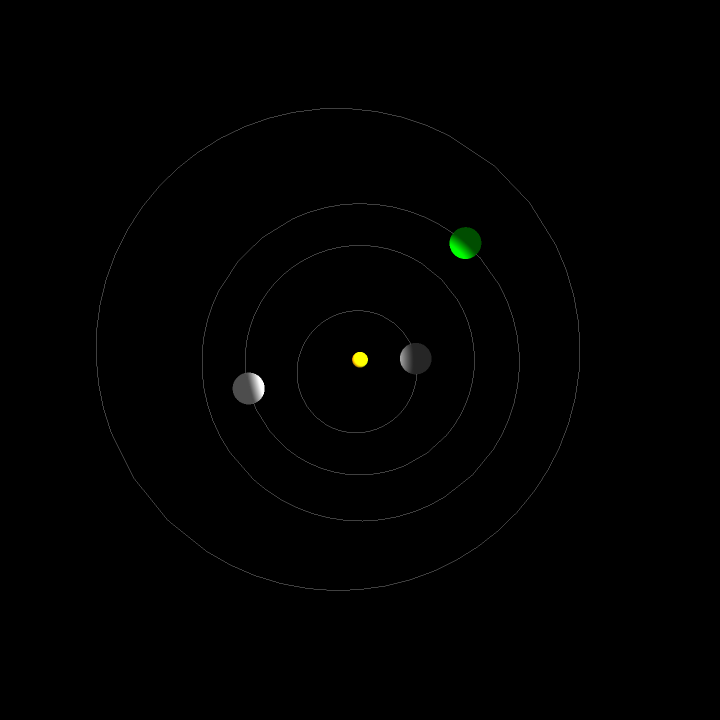 |
Wolfram Language 11.3 (March 2018) or above
This work is licensed under a Creative Commons Attribution 4.0 International License